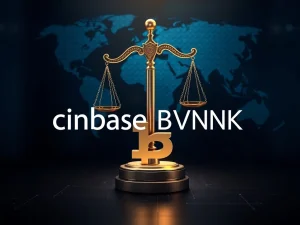Urgent DeFi Security Breach Averted: Researchers Foil $10M Smart Contract Backdoor

Imagine a hidden threat lurking in thousands of digital vaults, ready to siphon away millions of dollars without a trace. This wasn’t a hypothetical scenario; it was a silent crisis recently averted in the decentralized finance (DeFi) world. Thanks to vigilant crypto security researchers, a sophisticated crypto backdoor that could have led to over $10 million in losses was discovered and neutralized, highlighting the constant battle for DeFi security.
DeFi Security Under the Microscope: Averting a Catastrophe
For months, an insidious exploit silently threatened the vast DeFi ecosystem. This was no ordinary bug; it was a cunningly placed backdoor targeting uninitialized ERC-1967 proxy contracts. Think of it like a master key hidden in plain sight, allowing an attacker to seize control of smart contracts even before they were fully operational. The potential for widespread damage was immense, threatening the integrity and user trust in numerous DeFi protocols.
The pseudonymous Venn Network researcher Deeberiroz revealed the exploit on X, sparking an immediate, high-stakes rescue operation. This wasn’t a solo mission; it involved a dedicated team including security researchers Pcaversaccio, Dedaub, and Seal 911. Their 36-hour race against time was critical: identify affected contracts, assess the risk, and secure vulnerable funds before attackers could strike.
Unpacking the Smart Contract Vulnerability: How the Backdoor Operated
The core of this threat lay in a clever manipulation of smart contract deployments. Or Dadosh, co-founder and president of Venn Network, explained that attackers essentially ‘front-ran’ legitimate contract deployments. By doing so, they injected malicious implementations, creating a well-hidden backdoor in thousands of contracts across various EVM chains. This meant the attacker could have taken over these vulnerable contracts at any point, and once the contract was initialized, their malicious activity would become nearly invisible.
The exploit’s stealth was its most terrifying aspect. An undetected, unremovable backdoor existing for months meant that even after a contract was set up and running, the attacker retained covert access. This made detection incredibly difficult, posing a significant challenge for ongoing blockchain security efforts.
Key Characteristics of the Attack:
- Target: Uninitialized ERC-1967 proxy contracts.
- Method: Front-running contract deployments to inject malicious code.
- Stealth: Backdoor became nearly invisible post-initialization.
- Reach: Thousands of contracts across multiple EVM chains were vulnerable.
The Unseen Threat: Why This Crypto Backdoor Was So Dangerous
The immediate risk was estimated at tens of millions of dollars, with several DeFi protocols able to secure hundreds of thousands in crypto thanks to the swift intervention. However, the true danger extended far beyond the immediate financial exposure. Dadosh emphasized that if left unchecked, this crypto backdoor could have continued to grow, threatening a much larger portion of the total value locked (TVL) across involved protocols. This highlights a critical challenge in DeFi: a single, sophisticated vulnerability can have cascading effects, undermining trust and stability across the entire ecosystem.
One notable affected protocol was Berachain. Upon learning of the potential vulnerability, the Berachain Foundation acted decisively, pausing its incentive claim contract and transferring funds to a new, secure contract. Their rapid response ensured that no user funds were lost, reinforcing the importance of proactive security measures and transparent communication in the face of threats.
Tracing the Attack: Was the Lazarus Group Involved?
While the immediate threat has been contained, the question of attribution remains. Venn Network security researcher David Benchimol suspects the infamous North Korean hacking group, Lazarus, may be involved. Benchimol noted the attack’s extreme sophistication and its widespread deployment across every EVM chain as indicators of an organized, state-sponsored actor. The attackers also appeared to be waiting for a larger target, a common tactic for groups like Lazarus that seek high-impact scores.
However, it’s crucial to note that there is no definitive confirmation of Lazarus Group involvement at this time. The investigation is ongoing, but the characteristics of the attack vector certainly align with the group’s known modus operandi for complex cybercrime operations.
Strengthening Blockchain Security: Lessons for the Future
This averted crisis serves as a powerful reminder of the continuous need for robust blockchain security. For users, it underscores the importance of choosing reputable protocols with strong security track records and understanding the risks associated with decentralized finance. For developers and project teams, it highlights several actionable insights:
- Rigorous Auditing: Regular, in-depth security audits by multiple independent firms are paramount, especially for critical components like proxy contracts.
- Proactive Monitoring: Implementing sophisticated monitoring systems to detect unusual contract deployments or interactions can provide early warnings.
- Incident Response Plans: Having a well-rehearsed incident response plan is crucial for swift and effective mitigation during a security breach.
- Community Collaboration: The success of this rescue operation demonstrates the power of collaborative efforts within the security research community.
- Supply Chain Security: Developers must also consider the security of their deployment pipelines and third-party tools, as vulnerabilities there can be exploited.
The ongoing cat-and-mouse game between security researchers and malicious actors means that vigilance is non-negotiable. While the DeFi space offers incredible innovation, it also presents unique attack surfaces that demand constant attention and improvement in security practices.
This incident is a testament to the dedication of security researchers who work tirelessly to protect the decentralized world. Their quick thinking and collaborative efforts prevented a potentially devastating loss, reinforcing the resilience of the DeFi ecosystem when faced with sophisticated threats. As the crypto landscape evolves, continuous investment in cutting-edge blockchain security will be vital to safeguard digital assets and maintain trust in the future of finance.







